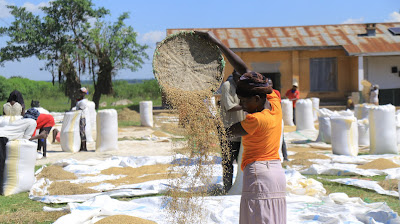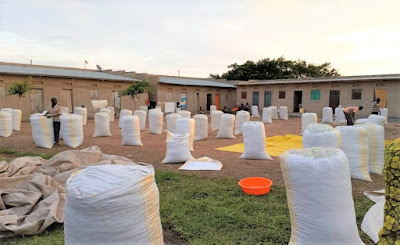About the Agriculture Cluster Development Project
Introduction
The Agricultural Cluster Development Project (ACDP) is
a six-year development project implemented by the Ministry of Agriculture Animal Industry
and Fisheries and funded by the World Bank. It is implemented in 12
geographical clusters covering 55 districts. The project targets the development of five commodities of
Maize, Rice, Beans, Cassava, and coffee.
The objective of the project is “To raise on-farm productivity,
production, and marketable volumes of selected agricultural commodities in
specified geographical clusters”
Project components
The project has four key components
Component
1: Support to the intensification of on-farm production
Component
2: Value addition and Market Access
Component
3: Policy, Regulatory and Institutional support
Component
4: Coordination and Management, and ICT Platform
Project beneficiaries
The project target to reach 450,000 farmers,
especially smallholders, and other value chain actors at the local, district
and the national level. These include
§
300
Area-based Commodity Cooperative Enterprises
§
3,000
Rural Producer Organizations
§
30,000
farmer groups
The Rural producer organizations represent 450,000
farming households, of which
§
180,000
are producers of maize (50 percent of these also produce beans),
§
95,000
are producers of beans,
§
40,000
are producers of rain-fed upland and rain-fed lowland rice,
§
110,000
are producers of Robusta and Arabica coffee, and
§
25,000
are producers of cassava
Subsidy Program
One
of the core mandates of the project is the e-subsidy program. This is where
farmers contribute towards the purchase of key inputs needed to intensify
production of one of the prioritized
commodities, on one acre of their farms and improve post-harvest handling
through investing in farm-level storage. The instrument for providing a
time-bound, partial, and diminishing matching grant for the purchase of key
farm inputs is the e-Voucher. Eligible farm households receive an e-Voucher that
covers part of the expense involved in the purchase of a group of inputs
(fertilizer, seed, on-farm storage, access to technical and market information)
Each farm household chooses the specific combination
of inputs purchased through the e-Voucher system from the menu of eligible
inputs through ICT tools including mobile phones).
The
private sector plays the role of ensuring that inputs reach the farmers
bringing in a key element of production, quality inputs and establishing input
stores in the villages
The matching grant
The smart subsidy is time-bound and declines through three cropping cycles. In season one government
grants 67% subsidy, in season two 50%, and in season three 37%. After cycle 3,
the farmer is expected to have graduated both financially and in knowledge to
effectively afford the full cost of the inputs and therefore require no
subsidy. Access to the inputs is through a 7- step-voucher process as
illustrated below;
The E-Voucher flow-chart
Some of the key project achievements
1)
Total registration numbers stand at
118,444 farmers registered in 24 pilot cluster districts representing 90% of
the targeted number of project beneficiaries.
2)
Total number of
farmers enrolled in the e-voucher system increased from 13,859 farmers (May
2019) to 46,404 farmers (27,384
males and 19,020 females)
representing 34% of the target beneficiaries
3) 20,615
farmers have received inputs (40% female), this is an
increment (123%) from the 9,240 farmers that
received inputs in the last season (Season A 2019) in
the 18 pilot cluster districts
4)
572 chokepoints on 376 roads along 2,440
km have identified and prioritized for
rehabilitation in the 17 Roll-Out districts,
5) 39
Agro-input dealers have been accredited to provide services to farmers under
the project.
6)
Agribusiness matchmaking expo to
facilitate contractual partnerships between the selected 123 agribusiness
producer organizations and suppliers of post-harvest management and agro
processing equipment and service was held at Namboole on 18th
November 2019. The first set of FOs are expected to receive grants in December
2019.
7)
Systems failure with the e-voucher
management system have been resolved, The use of mobile money for making payments
has been added to the e-Voucher system to mitigate the challenges of the
banking system.
8)
So far 89,437 farmers from 2,100 villages
in the 5 pilot districts have been registered using the farmers ’registers. Starting in 2020, this data will be captured
at the district level by all Parish Chiefs with support from Extension Workers and
LC1 Chairpersons.




Comments
Post a Comment